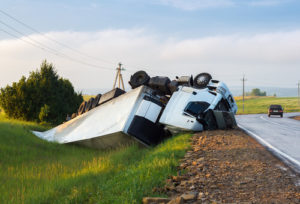
The dangers of drunk driving are well known. People also recognize the dangers associated with distracted driving, such as when drivers take their eyes off the road to send text messages. However, drowsy driving is a danger that does not receive as much recognition as it should.
Drowsy driving causes car accidents in much the same way as drunk driving does. Drowsiness reduces alertness and slows the driver’s thought processes and reflexes. Closing your eyes for a few seconds can cause you to crash or lose control of your vehicle. Wrecks involving drowsy drivers can be especially severe because drivers who fall asleep at the wheel may not apply the brakes or take any evasive actions to reduce the impact of the collision.
How Widespread is Fatigued Driving?
The statistics published by national safety organizations about drowsy and fatigued driving are startling.
In February 2018, the AAA Foundation for Traffic Safety said drowsy driving plays a role in 9.5 percent of all car crashes and 10.8 percent of significant property damage car accidents. AAA says its findings indicate the portion of crashes involving drowsiness is nearly eight times higher than federal estimates indicate.
For the first-of-its-kind study, AAA researchers used in-car cameras to record 3,500 drivers over several months, and a scientific measure linking the percentage of time a person’s eyes were closed to their level of drowsiness.
Interestingly, the National Sleep Foundation says that Australia, England, Finland, and other European nations all have more consistent procedures for reporting drowsy driving crashes than the U.S., and they report that drowsy driving represents 10 to 30 percent of all crashes.
In the U.S., the National Highway Traffic Safety Administration (NHTSA) says there were 803 drowsy-driving deaths in 2016. Between 2011 and 2015 there was a total of 4,121 crashes related to drowsy driving, NHTSA says. The statistics are based on police accident reports. But police reports may undercount drowsy driving as a contributing factor in crashes. Many drivers who survive drowsy driving crashes are reluctant to admit they were nodding off at the wheel when the accident occurred.
The National Sleep Foundation says only 27 percent of Americans get the recommended amount of sleep, which is 7 to 9 hours in every 24 hours (each day). Sixty-five percent report getting less sleep than is recommended, and 8 percent say they get more.
Drowsy Driving is Impaired Driving
The National Safety Council compares driving while drowsy to driving under the influence of alcohol. It says:
- Drivers’ reaction times, awareness of hazards and ability to pay attention all get worse as the driver gets drowsier.
- Driving after more than 20 hours without sleep is the equivalent of driving with a blood-alcohol concentration of 0.08 percent, the legal threshold for drunk driving throughout the United States.
- A driver is three times more likely to be in a car crash if he or she is fatigued.
Oklahoma has adopted the National Safety Council’s Our Driving Concern program, which provides resources geared to employers about drowsy driving and other traffic safety topics.
Oklahoma Driving Concern says the best advice about drowsy driving is to learn the signs of drowsiness — head-bobbing, yawning, etc. — and, if you’re tired, pull over. Its other suggestions are:
- Take a nap (20 minutes of sleep can alleviate feelings of drowsiness, at least temporarily).
- Drink a caffeinated beverage (coffee or cola).
- Schedule travel breaks (use this web page to locate Oklahoma rest areas).
An NHTSA study determined that a drowsy driving crash is more like to occur:
- Late at night, usually after midnight. A smaller secondary peak in drowsy driving accidents occurs in the midafternoon when most Americans’ overnight sleep patterns leave them sleepy.
- On a high-speed road, such as rural highways and major roadways, which indicates longer travel than for local commutes or errands.
- While a driver is alone in the vehicle.
- With a single vehicle drifting off the roadway.
- With no attempt to avoid the crash.
The National Sleep Foundation says sleep-related crashes are most common among young people, especially young men, adults with children, and shift workers.
Law Enforcement and Drowsy Driving Prevention
Despite statistics that increasingly show a widespread traffic safety risk from drowsy driving, fatigued driving is not against the law in Oklahoma or most other states. In fact, only two states, New Jersey and Arkansas, have laws expressly addressing drivers who drive while drowsy and subsequently injure or kill someone.
Even under laws that exist, meeting the standards for prosecution and conviction is difficult, a 2017 report from the Pew Charitable Trusts says. Arkansas requires proving the driver hadn’t slept for 24 consecutive hours, and New Jersey sets the time at more than 24 hours. Arkansas has had only three convictions since 2013, when the law took effect.
Part of the problem, Pew says, is that “when a fatigued driver is stopped by police, adrenaline usually kicks in and he doesn’t appear to be sleepy.” As the National Sleep Foundation says, there is no test to determine sleepiness as there is for intoxication, i.e., a “Breathalyzer.”
According to Pew, safety advocates say states should:
- Make highway rest areas available for tired drivers.
- Install rumble strips on highways.
- Include information about drowsy driving in driver’s manuals and driver’s education classes.
- Conduct public education campaigns.
Contact Us If You Suspect Drowsy Driving in a Car Crash
While drowsy drivers in Oklahoma may not be subject to the same penalties as drunk drivers, they are still responsible for any damage or injury caused by their decision to drive while impaired by fatigue or lack of adequate sleep.
If you have been hurt in a car accident caused by a drowsy driver, or a fatigued truck driver operating a tractor-trailer, you need the help of an experienced personal injury lawyer. The car accident attorneys at Ryan Bisher Ryan & Simons in Oklahoma City can help you pursue all available damages under the law. Contact us today to arrange your free initial consultation.


